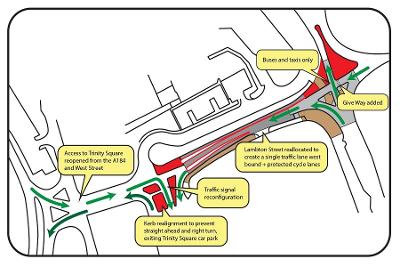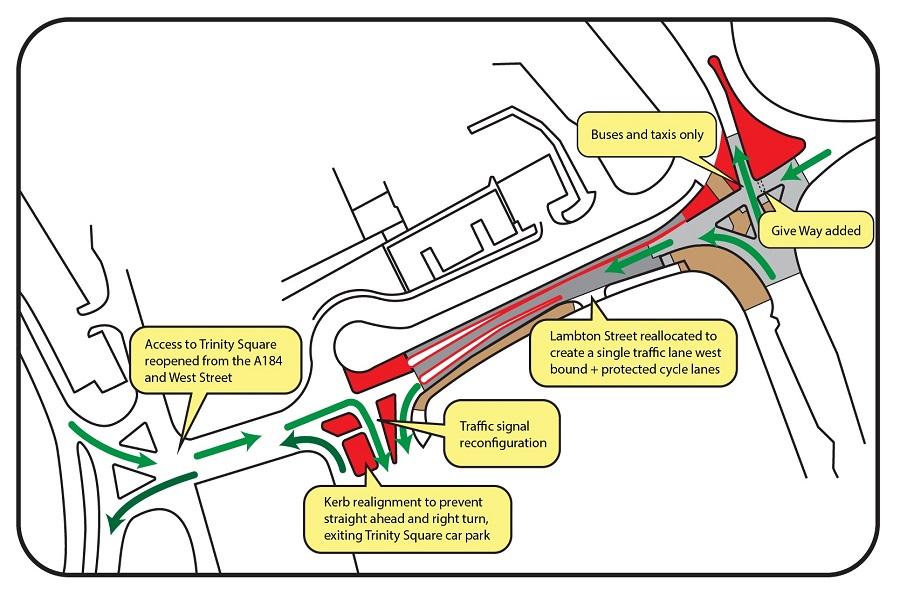Investment in key town centre junctions

Key junctions at the north end of Gateshead town centre are to benefit from investment to improve journey times and traffic flow, and prioritise bus journeys.
The junction between High Street and Lambton Street will be simplified, and the traffic signals removed, to give buses priority to travel northwards towards Newcastle, and reduce the number of traffic lanes for pedestrians to cross.
The access in and out of the car park for Trinity Square Gateshead will also be redesigned and improved.
Currently, drivers can only access the Trinity Square car park from the east, but now drivers will be able to access the town centre car park from both east (A167 and Tyne Bridge side) and west (near Old Town Hall at the bottom of West Street).
This will open up easier access for drivers who until now have needed to arrive via High Street or the A167.
Meanwhile all traffic leaving Trinity Square will now exit to the west, joining the southbound West Central Route (towards the Civic Centre), simplifying traffic movements and the phasing of traffic lights at the car park exit.
Our surveys show it is the junctions rather than the roads that are at capacity. Minimising disruption at these junctions means more traffic can get through and that's why our focus is on minimising the number of junctions and traffic movements, and increasing the traffic light timings based on where most of the traffic comes from.
A survey of vehicles leaving the Trinity Square car park found 85% of drivers already choose to turn to the west (left turn) so the new layout will mean the vast majority of drivers will still be able to travel exactly the same route.
The council wants to make it easier for residents from all the existing and new houses in the west of Gateshead to get to the town centre car park and back out again. Signage will also be improved.
These works support the council's strategy to link the town centre with the Railway Quarter and the quays area, with direct and safe routes to and from the bus and Metro interchange, and to the surrounding residential areas.
In addition, the council is acutely aware that almost a third of North East households have no access to a car, and for many people, walking or cycling, or using the bus or Metro, are vital to get to work, education or health appointments, and to access cultural and leisure venues.
In addition to the works to give buses priority, the council will also be installing a 'raised table' at the junction of High Street and Lambton Street to reduce the speed of traffic.
Colin Swinney, Service Director for Highways and Waste at Gateshead Council, said:
"We're very glad to get this project approved and ready to be installed. The works to these junctions will improve the north end of the town centre significantly.
"It's vital that we use the latest traffic management knowledge and technology, and prioritise bus journeys, so we can move the maximum possible number of people, as efficiently as possible.
"Trinity Square shoppers and local residents have also had to put up with the unsightly temporary barriers down Lambton Street for a long time now, and this scheme will clear all those away."
The changes to the road layouts here are also important to prevent drivers taking short cuts, known as rat running, which can be dangerous for pedestrians, and also affect the reliability and punctuality of public transport.
Meanwhile a segregated cycle lane will be added to Lambton Street to improve active travel access to the Trinity Square car park.
All the materials used in the works will be high quality, to ensure they fit with the local Conservation Area.
The new layout will be put in place using temporary barriers from next week (30th June), to allow drivers to benefit immediately from the improved access.
Town centre traders asked the council to demonstrate the impact of our proposals through the use of temporary barriers, so we are doing this in advance of implementing the full scheme.
Work on the permanent layout is expected to start in September, dependent on the delivery of key materials.
A large amount of the work will be completed on over night shifts, to minimise disruption to local businesses and drivers during peak time hours.
The works will be carefully scheduled, in coordination with the demolition of the Gateshead Highway flyover, so any disruption to drivers will be minimised.
The works to the High Street / Lambton Street junction are being paid for through national Bus Service Improvement Plan (BSIP) funding.
The North East's Bus Service Improvement Plan (BSIP), approved by the Joint Transport Committee (JTC), is designed to enable region-wide ambitions to make buses more attractive, by making them an affordable, timely and practical alternative to using private cars.
The bus operator along this corridor, Stagecoach, is supportive of the scheme which will assist in improving the reliability of their routes.
The BSIP funding pays for the majority of the Lambton Street works, with the cycle priority works paid for from the Active Travel Fund, which is managed by Active Travel England.
These works will also help the council's longer term plans to improve capacity and layout on the Oakwellgate junction on the A167 and improve the environment of the area around the Old Town Hall.
For pedestrians crossing the junction between High Street and Lambton Street, these works will reduce the number of vehicle movements through the junction, and slow traffic speeds through the installation of the raised table, creating a more pedestrian-friendly environment.

Key junctions at the north end of Gateshead town centre are to benefit from investment to improve journey times and traffic flow, and prioritise bus journeys.
The junction between High Street and Lambton Street will be simplified, and the traffic signals removed, to give buses priority to travel northwards towards Newcastle, and reduce the number of traffic lanes for pedestrians to cross.
The access in and out of the car park for Trinity Square Gateshead will also be redesigned and improved.
Currently, drivers can only access the Trinity Square car park from the east, but now drivers will be able to access the town centre car park from both east (A167 and Tyne Bridge side) and west (near Old Town Hall at the bottom of West Street).
This will open up easier access for drivers who until now have needed to arrive via High Street or the A167.
Meanwhile all traffic leaving Trinity Square will now exit to the west, joining the southbound West Central Route (towards the Civic Centre), simplifying traffic movements and the phasing of traffic lights at the car park exit.
Our surveys show it is the junctions rather than the roads that are at capacity. Minimising disruption at these junctions means more traffic can get through and that's why our focus is on minimising the number of junctions and traffic movements, and increasing the traffic light timings based on where most of the traffic comes from.
A survey of vehicles leaving the Trinity Square car park found 85% of drivers already choose to turn to the west (left turn) so the new layout will mean the vast majority of drivers will still be able to travel exactly the same route.
The council wants to make it easier for residents from all the existing and new houses in the west of Gateshead to get to the town centre car park and back out again. Signage will also be improved.
These works support the council's strategy to link the town centre with the Railway Quarter and the quays area, with direct and safe routes to and from the bus and Metro interchange, and to the surrounding residential areas.
In addition, the council is acutely aware that almost a third of North East households have no access to a car, and for many people, walking or cycling, or using the bus or Metro, are vital to get to work, education or health appointments, and to access cultural and leisure venues.
In addition to the works to give buses priority, the council will also be installing a 'raised table' at the junction of High Street and Lambton Street to reduce the speed of traffic.
Colin Swinney, Service Director for Highways and Waste at Gateshead Council, said:
"We're very glad to get this project approved and ready to be installed. The works to these junctions will improve the north end of the town centre significantly.
"It's vital that we use the latest traffic management knowledge and technology, and prioritise bus journeys, so we can move the maximum possible number of people, as efficiently as possible.
"Trinity Square shoppers and local residents have also had to put up with the unsightly temporary barriers down Lambton Street for a long time now, and this scheme will clear all those away."
The changes to the road layouts here are also important to prevent drivers taking short cuts, known as rat running, which can be dangerous for pedestrians, and also affect the reliability and punctuality of public transport.
Meanwhile a segregated cycle lane will be added to Lambton Street to improve active travel access to the Trinity Square car park.
All the materials used in the works will be high quality, to ensure they fit with the local Conservation Area.
The new layout will be put in place using temporary barriers from next week (30th June), to allow drivers to benefit immediately from the improved access.
Town centre traders asked the council to demonstrate the impact of our proposals through the use of temporary barriers, so we are doing this in advance of implementing the full scheme.
Work on the permanent layout is expected to start in September, dependent on the delivery of key materials.
A large amount of the work will be completed on over night shifts, to minimise disruption to local businesses and drivers during peak time hours.
The works will be carefully scheduled, in coordination with the demolition of the Gateshead Highway flyover, so any disruption to drivers will be minimised.
The works to the High Street / Lambton Street junction are being paid for through national Bus Service Improvement Plan (BSIP) funding.
The North East's Bus Service Improvement Plan (BSIP), approved by the Joint Transport Committee (JTC), is designed to enable region-wide ambitions to make buses more attractive, by making them an affordable, timely and practical alternative to using private cars.
The bus operator along this corridor, Stagecoach, is supportive of the scheme which will assist in improving the reliability of their routes.
The BSIP funding pays for the majority of the Lambton Street works, with the cycle priority works paid for from the Active Travel Fund, which is managed by Active Travel England.
These works will also help the council's longer term plans to improve capacity and layout on the Oakwellgate junction on the A167 and improve the environment of the area around the Old Town Hall.
For pedestrians crossing the junction between High Street and Lambton Street, these works will reduce the number of vehicle movements through the junction, and slow traffic speeds through the installation of the raised table, creating a more pedestrian-friendly environment.
